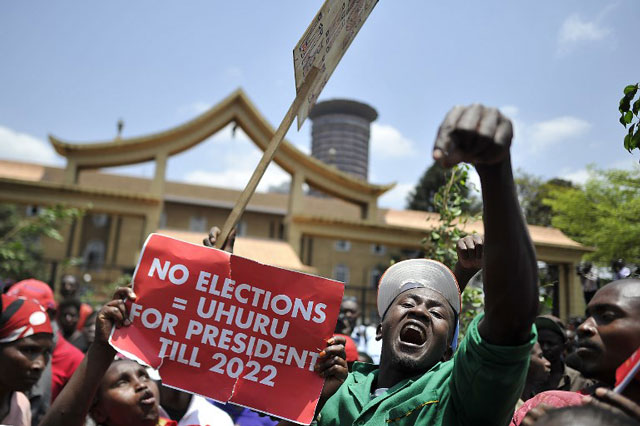
Uhuru Kenyatta was sworn in as president of Kenya on Tuesday following two disputed polls and waves of deadly protests.
Here are the key developments in the divisive election drama:
– Tensions on voting day –
Voters turn out in large numbers on August 8 after a tight race between Kenyatta and Raila Odinga, his longtime rival.
Many fear a repeat of the violence that after the 2007 election left more than 1,100 people dead.
Early results give Kenyatta a comfortable lead but are immediately rejected by Odinga, who claims hackers broke into the electoral commission database and manipulated the results.
The official results, published on August 11, give Kenyatta 54.27 percent to Odinga’s 44.74 percent.
Violent protests erupt in Odinga strongholds. The Kenya National Commission on Human Rights says 37 people are killed, most of them by police.
– Historic annulment –
Odinga files a complaint to the Supreme Court. In a shock announcement on September 1, judges declare the results of the poll “invalid, null and void” and order a re-run within 60 days.
The annulment is a first for Africa.
The date for a new election is later set as October 17.
– New vote postponed –
After the Supreme Court releases a detailed judgement lambasting the handling of the vote, the election commission on September 21 pushes back the re-run to October 26.
Kenya’s chief prosecutor on September 23 orders an investigation into the commission.
Late September the ruling Jubilee Party introduces a bill seeking to resolve “ambiguity” in the electoral law.
The opposition condemns the move as an effort to render legal some of the “irregularities and illegalities” cited in the Supreme Court’s cancellation of the vote.
– Odinga pulls out –
Protests erupt in early October as Odinga calls on his supporters to pressure the government to overhaul the election commission.
At least three people are killed in the violence that follows.
On October 10 Odinga withdraws from the re-run, saying the election panel has failed to make needed reforms.
He also says this does not mean his battle is over.
– Commissioner quits –
One of Kenya’s seven election commissioners, Roselyn Akombe, announces on October 18 that she has quit and fled the country.
The commission chief Wafula Chebukati also casts doubt on his organisation’s ability to hold a credible vote, accusing both major parties of interference.
Odinga tells a rally of thousands of supporters the same day that there will be “no election” and calls for nationwide demonstrations on polling day.
– Kenyatta wins again –
A fresh election is held on October 26, with Kenyatta winning 98 percent of the vote as Odinga’s call for a boycott is held.
Kenyatta hails his crushing win as vindication of his August victory. Odinga meanwhile says Kenya is moving towards “outright dictatorship”.
On November 20, the Supreme Court dismisses two petitions to overturn the October election, upholding the result.
On Tuesday, crowds pour into a Nairobi stadium for Kenyatta’s swearing-in ceremony.
Opposition supporters attempt to hold a rally for the more than 50 killed in four months of upheaval, but are met by volleys of tear gas and running battles with police.
 The Independent Uganda: You get the Truth we Pay the Price
The Independent Uganda: You get the Truth we Pay the Price


